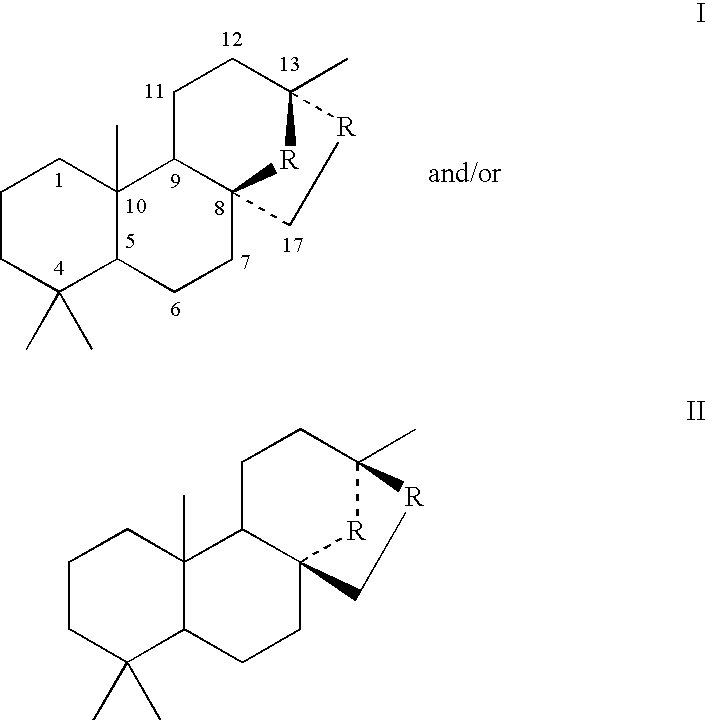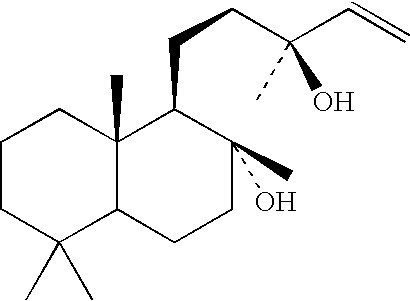Process for the manufacture of spiroketals
a technology of spiroketal and process, applied in the field of new products, can solve the problems of reducing the commercial value of the final product for the application in the perfumery industry, and achieve the effect of reducing the commercial value of the final produ
- Summary
- Abstract
- Description
- Claims
- Application Information
AI Technical Summary
Problems solved by technology
Method used
Image
Examples
example 1
[0017] Conversion of Larixol Using Bensingtonia ciliata ATCC 20919, Cryptococcus laurentii ATCC 20920, Cryptococcus albidus saito, skinner var. albidus ATCC 20918, Cryptococcus albidus ATCC 20921.
[0018] The following medium was prepared:
NH4NO30.1%KH2PO40.1%MgSO4.7H2O0.05% Yeast Extract0.2%
[0019] 4 Flasks were prepared. Each 500 ml flask contained 100 ml medium and 1 gram of Manool (98%) in Pluronic L92® (2:1).
[0020] Each flask was inoculated with 5 ml of a 48 hour grown cell culture in dextrose at 25° C., and 150 revolutions per minute (rpm). Product and substrate was monitored by gas chromatography (GC) against known standards.
[0021] In the following table the following codes are used:
S: Substrate
P: Product
I: Intermediate
TI: Trace Intermediate.
[0022] The “substrate” is Larixol having the structure:
[0023] The “product” is Manool having the structure:
[0024] The “intermediate” is Larixol ketone having the structure:
[0025] The “trace intermediate” is Manool ketone h...
example 2
[0026] Preparation of Manool from Larixol using Bensingtonia ciliata ATCC 20919 Reactions:
[0027] The following medium was prepared:
NH4NO30.1%KH2PO40.1%MgSO4.7H2O0.05% Yeast Extract0.2%Dextrose 1%
[0028] Into a 500 ml flask was placed 100 ml medium and a 1:1 mixture of Larixol powder: Pluronic L92®. 1 gram of the Manool and 1 gram of Pluronic L92® mixture was added to the flask and inoculated with 5 ml of isolate of Bensingtonia ciliata ATCC 20919. After one week at 25° C. and 150 rpm, the resulting product was extracted with 300 ml volumes of ethyl acetate and then dried over anhydrous sodium sulfate. The solvent was removed on a rotary evaporator. The residue was dissolved in ethyl acetate. The resulting extract permitted to evaporate for a period of 24 hours where upon crystal (150 mg) of Manool was recovered.
example 3
[0029] Conversion of Manool Using Bensingtonia ciliata ATCC 20919, Cryptococcus laurentii ATCC 20920, Cryptococcus albidus saito, skinner var. albidus ATCC 20918, Cryptococcus albidus ATCC 20921.
[0030] The following medium was prepared:
NH4NO30.1%KH2PO40.1%MgSO4.7H2O0.05% Yeast Extract0.2%
[0031] Four flasks were prepared. Each 500 ml flask contained 100 ml medium and 1 gram of Manool (98%) in Pluronic L92® (2:1).
[0032] Each flask was inoculated with 5 ml of a 48 hour grown cell culture in dextrose at 25° C., and 150 revolutions per minute (rpm). Product and substrate was monitored by gas chromatography (GC) against known standards.
[0033] In the following table the following codes are used:
S: Substrate
P: Product
I: Intermediate
TI: Trace Intermediate.
[0034] The “substrate” is Manool having the structure:
[0035] The “product” is Manool Ketone having the structure:
[0036] The “intermediate” is Manool Alcohol having the structure:
[0037] The “trace intermediate” is Manool ...
PUM
 Login to View More
Login to View More Abstract
Description
Claims
Application Information
 Login to View More
Login to View More - R&D
- Intellectual Property
- Life Sciences
- Materials
- Tech Scout
- Unparalleled Data Quality
- Higher Quality Content
- 60% Fewer Hallucinations
Browse by: Latest US Patents, China's latest patents, Technical Efficacy Thesaurus, Application Domain, Technology Topic, Popular Technical Reports.
© 2025 PatSnap. All rights reserved.Legal|Privacy policy|Modern Slavery Act Transparency Statement|Sitemap|About US| Contact US: help@patsnap.com



